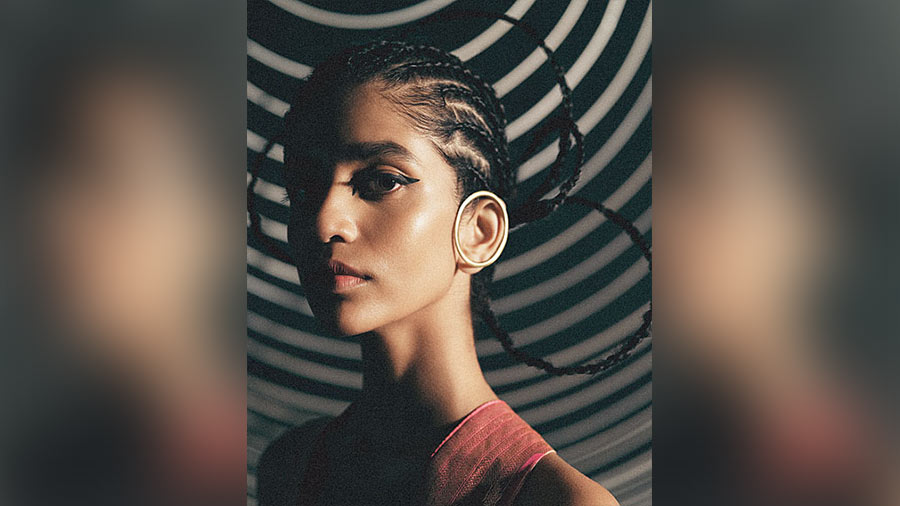Shanti Banaras’s Jamiti that draws inspiration from S.H. Raza’s ‘study of the Bindu’, is bold, dramatic and strong. Shot beautifully against installations, the collection is for women who believe in “not taking up any less space than they deserve”, says Khushi Shah, creative director and founder, Shanti Banaras. She herself loves wearing saris. “I love carrying embroidered saris. It’s always about how you style it,” she tells in a chat.
The major production for Shanti Banaras happens in Benaras and besides real zari saris, the brand also designs hand-embroidered shawls, dupattas, hand-embroidered Benarasi saris, hand-embroidered artwork, Benarasi lehngas and hand-embroidered bridal lehngas.
Khushi decodes Jamiti for The Telegraph and unlocks the secret to the everlasting allure of a Benarasi.
What drew you to S.H. Raza?
The whole idea was how Raza thought of Bindu and his whole concept was simple geometric shapes and striking colour combinations... that was interesting for us. The recall value that most people have is about Shanti being rooted to tradition, which we are but in a way we wanted to break that flow and working with old zari and weaves, create a concept that is a bit more geometrical. These were also Raza’s inspirations in a way. In those times, he used modern art.
What was the language of translation like, from the canvas to the clothes?
The designs were not inspired by each and every motif he used, but our way of weaving also. We have always done geometricals in our saris also. We have our age-old real zari saris and do the rangkat concept in triangles with that. We have also experimented with newer techniques. We have one of the lehngas which had multiple colours like orange, red and all of that combined. This was also inspired by one of Raza’s paintings. When you see separate kaalis of it, you would think it is super bold for someone to wear all those colours together, but when we stitched it, the rhythm of the whole thing came out so well. It is a fresh look. I am a big fan of bright colours.
Jamiti (geometry in India) is an interesting name...
We wanted to keep that fair balance between modern and traditional. Since the designs were modern, the colours were according to the new age. To bind the whole thing, Jamiti is something that resonates with Shanti.
The looks are strong. Who is your muse?
It is an ode to all women who are bold and powerful and sort of own their personality and are not taking up any less space than they deserve. Everyone is our muse... women who are trying to make a difference each day. Being confident in their personalities is the sort of women we are looking at. Even in the campaign, the expressions are like super bold, like ‘you can’t mess with us’.
The campaign is so edgy. How did you shoot it?
Oh it was the most intense planning. We planned it around two months back when we were thinking how can we make this campaign different. We wanted to not only make it about Bindu, but also geometric art. The photographer Pranoy and I came up with this idea to use motifs of our lehngas and create a background of that. We created around eight different set-ups comprising eight big metal wire installations. The set was grand.
You opened just before the pandemic, right?
In Delhi, it’s been one year, but in Benaras we’ve been there for four years. In Benaras, it was more of a commercial viewpoint, we were catering to the Benaras market and then we decided to take it to the next level with our weaves. We started a whole different collection in our Delhi store, which was of intense hand embroidery. You will see artworks. It’s taken us one or two years to create each and every artwork.
I come from a family that has dealt in handloom for years, almost 70-80 years. We as the third generation decided to take this forward and take it to a retail segment where we can directly connect with the consumers.
We are one of the only brands that has a vault of around 200 real zari saris and that’s the only thing we are selling in our Delhi store. It is hard to try and sell a real zari sari because the Indian markets have stopped believing in it because tested zari and antique zari has taken over. So, it was a big risk doing that also where the starting price is 1.5lakhs, but it’s been amazing to see that when people come to the store, they say that they don’t find such saris anywhere because everyone is trying to do modern colours and embroidery.
During the pandemic, we were trying to sell online for the most part. So that worked out well.

'Everyone is our muse... women who are trying to make a difference each day'
Who is the brand named after?
It was actually my grandmother’s name. My brother Amrit and I started the brand and it was an ode to our grandmother. Her everyday attire was a sari and she used to look so comfortable and elegant.
Benaras as a concept is saturated. What did you keep in mind to ensure that the brand stands out?
Number one is of course the real zari saris and number two which we started was the artwork, like hand-embroidered pichwais. It opens up a whole new wing (of employment) for the weavers.
What do you attribute the timelessness of a Benarasi to?
I feel it’s the lustrous splendour that each sari has. It’s intricate. We have saris that show the whole Ramayana and talks about Indian history. When you are buying, you are buying an heirloom piece. No one can do without buying a Benarasi for their trousseau.
